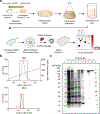SHERLOCK: nucleic acid detection with CRISPR nucleases
- PMID: 31548639
- PMCID: PMC6956564
- DOI: 10.1038/s41596-019-0210-2
SHERLOCK: nucleic acid detection with CRISPR nucleases
Erratum in
-
Author Correction: SHERLOCK: nucleic acid detection with CRISPR nucleases.Nat Protoc. 2020 Mar;15(3):1311. doi: 10.1038/s41596-020-0302-z. Nat Protoc. 2020. PMID: 32005984
Abstract
Rapid detection of nucleic acids is integral to applications in clinical diagnostics and biotechnology. We have recently established a CRISPR-based diagnostic platform that combines nucleic acid pre-amplification with CRISPR-Cas enzymology for specific recognition of desired DNA or RNA sequences. This platform, termed specific high-sensitivity enzymatic reporter unlocking (SHERLOCK), allows multiplexed, portable, and ultra-sensitive detection of RNA or DNA from clinically relevant samples. Here, we provide step-by-step instructions for setting up SHERLOCK assays with recombinase-mediated polymerase pre-amplification of DNA or RNA and subsequent Cas13- or Cas12-mediated detection via fluorescence and colorimetric readouts that provide results in <1 h with a setup time of less than 15 min. We also include guidelines for designing efficient CRISPR RNA (crRNA) and isothermal amplification primers, as well as discuss important considerations for multiplex and quantitative SHERLOCK detection assays.
Conflict of interest statement
Figures





Similar articles
-
PrimedSherlock: a tool for rapid design of highly specific CRISPR-Cas12 crRNAs.BMC Bioinformatics. 2022 Oct 14;23(1):428. doi: 10.1186/s12859-022-04968-5. BMC Bioinformatics. 2022. PMID: 36241974 Free PMC article.
-
Multiplexed and portable nucleic acid detection platform with Cas13, Cas12a, and Csm6.Science. 2018 Apr 27;360(6387):439-444. doi: 10.1126/science.aaq0179. Epub 2018 Feb 15. Science. 2018. PMID: 29449508 Free PMC article.
-
CRISPR-Cas Systems: Programmable Nuclease Revolutionizing the Molecular Diagnosis.Mol Biotechnol. 2024 Aug;66(8):1739-1753. doi: 10.1007/s12033-023-00819-7. Epub 2023 Jul 19. Mol Biotechnol. 2024. PMID: 37466850 Review.
-
CRISPR-Cas12-Based Diagnostic Applications in Infectious and Zoonotic Diseases.Methods Mol Biol. 2023;2621:267-278. doi: 10.1007/978-1-0716-2950-5_15. Methods Mol Biol. 2023. PMID: 37041450
-
Biosensing platforms for DNA diagnostics based on CRISPR/Cas nucleases: towards the detection of nucleic acids at the level of single molecules in non-laboratory settings.Biomed Khim. 2024 Sep;70(5):287-303. doi: 10.18097/PBMC20247005287. Biomed Khim. 2024. PMID: 39324194 Review.
Cited by
-
Point-of-care CRISPR/Cas nucleic acid detection: Recent advances, challenges and opportunities.Biosens Bioelectron. 2020 Oct 15;166:112445. doi: 10.1016/j.bios.2020.112445. Epub 2020 Jul 26. Biosens Bioelectron. 2020. PMID: 32758911 Free PMC article. Review.
-
SARS-CoV-2 RapidPlex: A Graphene-Based Multiplexed Telemedicine Platform for Rapid and Low-Cost COVID-19 Diagnosis and Monitoring.Matter. 2020 Dec 2;3(6):1981-1998. doi: 10.1016/j.matt.2020.09.027. Epub 2020 Oct 5. Matter. 2020. PMID: 33043291 Free PMC article.
-
Current progress on COVID-19 related to biosensing technologies: New opportunity for detection and monitoring of viruses.Microchem J. 2021 Jan;160:105606. doi: 10.1016/j.microc.2020.105606. Epub 2020 Oct 8. Microchem J. 2021. PMID: 33052148 Free PMC article. Review.
-
Current Trends in RNA Virus Detection via Nucleic Acid Isothermal Amplification-Based Platforms.Biosensors (Basel). 2024 Feb 11;14(2):97. doi: 10.3390/bios14020097. Biosensors (Basel). 2024. PMID: 38392016 Free PMC article. Review.
-
Rapid and accurate nucleobase detection using FnCas9 and its application in COVID-19 diagnosis.Biosens Bioelectron. 2021 Jul 1;183:113207. doi: 10.1016/j.bios.2021.113207. Epub 2021 Apr 5. Biosens Bioelectron. 2021. PMID: 33866136 Free PMC article.
References
Publication types
MeSH terms
Substances
Grants and funding
LinkOut - more resources
Full Text Sources
Other Literature Sources
Research Materials

